Chapter 17.510
SIGN CODE
Sections:
17.510.060 Conditionally exempt signs.
17.510.070 Regulations for permanent signs.
17.510.080 Regulations for electronic signs.
17.510.100 Sign detail sheets.
17.510.120 Nonconforming signs.
17.510.130 Contractor license.
17.510.010 Purpose.
This chapter establishes sign regulations and a clear enforcement strategy, which support and complement land use objectives set forth in the Kitsap County Comprehensive Plan, because unregulated signs may constitute a public nuisance for the health, safety, convenience, aesthetics, and welfare of Kitsap County residents. The sign code shall be updated periodically as necessary to maintain consistency with the Kitsap County Comprehensive Plan and respective subarea plans. Signs are necessary for public service and facilitate competitive commerce and industry. These sign standards and regulations establish a predictable review process for the use of signs that support the business community, community organizations, and public entities while also promoting the visual quality of Kitsap County and which may be promoted in community plans. The standards also promote safety and protect the general public from damage or injury caused by, or partially attributed to, the distractions, hazards, and obstructions which result from improperly designed or located signs. The following standards should not regulate the content on a sign; rather, the standards should apply to the design and location of a sign.
(Ord. 534 (2016) § 7(5) (App. E) (part), 2016)
17.510.020 Definitions.
“A-frame sign” means a two-panel sign made of wood, cardboard, plastic, or other lightweight and rigid material capable to stand on its own support(s) and is portable and movable. Also known as a sandwich board.
“Abandoned sign” means a sign whose (A) message does not correspond with the current building use; or (B) a sign which does not promote a commercial product or event and the content of the sign pertains to a time, event or purpose which has elapsed or expired in the preceding three hundred sixty-five days.
“Advertising wind sign” means a single- or double-sided sign or device which flutters, waves, sparkles, or otherwise moves from the pressure of air movement in or around the sign used to promote a product or business.
“Animation” means a visual effect using seamless action, motion, light, or color changes through electrical or mechanical means.
“Banner sign” means a sign made from fabric, vinyl, plastic, or other lightweight and flexible materials tied or fastened to a stationary object.
“Billboard” means a large, outdoor, permanent, commercial, off-premises structure advertising products or services, typically found in high traffic areas such as alongside busy roads. Billboards present large advertisements to passing pedestrians and drivers.
“Channel sign” means the use of bent metal or plastic to fashion channels in the shape of letters or symbols and covered with a translucent plastic face, often a colored acrylic with lighting behind it.
“Construction sign” means signs denoting a building which is under construction, structural alterations, or repair, which announce the character of the building enterprise or the purpose for which the building is intended, including names of architects, engineers, contractors, developers, financiers, and others.
“Contrast” means the difference or degree of difference in the appearance of adjacent surfaces, such as light and dark areas, different colors, or typefaces, and graphics appearing on various backgrounds.
“Copy area” means that area which displays the primary copy and secondary copy on a sign.
“County” means Kitsap County, a political subdivision of the state of Washington.
“Department” means the Kitsap County department of community development.
“Development sign” means a construction sign denoting the architect, engineer, contractor, subcontractor, financier or sponsor of a residential or commercial development which may also designate the future occupant or use of the development.
“Directional sign” means signs designed to provide direction to pedestrian and vehicular traffic.
“Electronic sign” means a static sign capable of displaying words, symbols, figures or images that can be electronically or mechanically changed by remote or automatic means.
“Event sign” means a sign posted to advertise a specific occurrence.
“Externally illuminated sign” means a sign illuminated by reflection of a light source aimed at its surface.
“Flashing” means a visual effect used on an electronic message center to allow one message to disappear while it is simultaneously being replaced by another.
“Freestanding sign” means a sign that is not attached to a building.
“Halo lighting effects” means channel signs that project light behind them, causing the light to reflect off of the signs’ mounting surface creating a silhouette of the letter and/or symbol.
“Human sign” means a sign carried, held, or supported by a person.
“Inflatable sign (continuous inflation)” means a sign that is a cold air inflated object, which may be of various shapes, made of flexible fabric, resting on the ground or structure and equipped with a portable blower motor that provides a constant flow of air into the device. Inflatable devices are restrained, attached, or held in place by a cord, rope, cable or similar method.
“Inflatable sign (noncontinuous inflation)” means a sign that is inflated once, typically with a mixture of gases, which may be of various shapes and sizes and held in place by a cord, rope, cable or similar method.
“Internally illuminated sign” means a sign that has the light source enclosed within it so the source is not visible to the eye.
LAMIRD. “Limited areas of more intense rural development” are formally recognized areas within Kitsap County wherein land use intensity is greater than allowed by county zoning regulations. The two types of LAMIRDs existing in Kitsap County are:
A. Type I (Keyport, Manchester, Port Gamble, Suquamish): The only type of LAMIRD currently designated in Kitsap County prior to 2010, this designation is characterized as infill development or redevelopment of existing commercial, industrial, residential, or mixed use areas, whether as shoreline development, villages, hamlets, rural activity centers, or crossroads. Any industrial development within a Type I LAMIRD must be principally designed to serve the rural population. Any new development or redevelopment must be consistent with existing character of the area with respect to building size, scale, use, or intensity. Type I LAMIRDs must have been established as more densely developed areas as of July 1990, and they must include pre-GMA existing development. Type I LAMIRDs also must be bounded by a “logical outer boundary” that mirrors the limits of the preexisting development.
B. Type III (12 Trees and Rural Employment Centers): includes intensification of or new development of lots for isolated cottage industries and isolated small-scale businesses. Residential development is prohibited. Type III LAMIRDs need not principally serve the rural population, but should provide job opportunities for rural residents. Expansion or new development must conform with the rural character of the area as defined by the local government. Public services and public facilities must be limited to those that are the minimum necessary to serve the industry or business.
“Legal nonconforming sign” means a sign that was permitted, legally erected, and is maintained but does not conform to the current sign code.
“Legibility” means the physical attributes of a sign that allow for differentiation of its letters, words, numbers, or graphics, which directly relate to an observer’s visual acuity.
“Name plate” means a sign used to identify and display the name of a person, product, or place.
“Navigational sign” means water-based wayfinding signs as identified by the United States adopted aids to navigation (U.S. ATONS).
“Off-premises sign” means an outdoor sign whose message directs attention to something that is not sold, produced, manufactured, furnished, or conducted at the property upon which the sign is located.
“On-premises sign” means a sign whose message and design relate to an individual business, profession, product, service, event, point of view, or other commercial or noncommercial activity sold, offered, or conducted on the same property where the sign is located.
“Organization” means an entity, including a natural person, which owns, operates, or maintains the sign.
“Permanent sign” means a sign attached to a building or structure, or to the ground in a manner that enables the sign to resist environmental loads, such as wind, and that precludes ready removal or movement of the sign and whose intended use appears to be indefinite.
“Political sign” means a sign providing information relating to a local, state, or national election, initiative, or referendum.
“Primary street frontage” means the lot line where the main visual entrance to the property is located.
“Public right-of-way (ROW)” means all property in which the county has any form of real property interest, and which is held for public road, shoulder, and sidewalk purposes, regardless of whether or not any road exists thereon or whether or not it is used, improved, or maintained for public travel.
“Public safety sign” means a sign that is necessary to reduce or eliminate the risk of imminent personal or property damage.
“Reader board” means a sign or portion thereof on which the copy or symbols change either automatically though electrical or electronic means (for example, time and temperature units), or manually though placement of letters or symbols on a panel mounted in or on a track system.
“Real estate sign” means a sign advertising the real property upon which the sign is located for rent, for lease, or for sale and providing the name and location of the owner or his agent.
“Rotating sign” means a sign wherein the faces or portions of a sign face mechanically revolve around a central axis.
“Scrolling” means a mode of message transition on an electronic message display where the message appears to move vertically across the display surface.
“Sign” means any device, structure, fixture, painting, visual image or logos associated with the business using words, graphics, symbols, numbers, or letters designed and used for the purpose of communicating a message or attracting attention.
“Signage” means an organization’s signs collectively used to communicate information or attract attention.
“Storefront facade” means the side of a building facing the street. The storefront width is measured from the walls of the structure, within which houses an organization. The height is measured from the finished grade to the top of storefront vertical wall. See Figure 1b, Attached Sign Total Area Example.
“Structural alteration” means modification of a sign, sign structure or awning that affects size, shape, height, or sign location; changes in structural materials; or replacement of electrical components with other than comparable materials. The replacement of wood parts with metal parts, the replacement of incandescent bulbs with light emitting diodes (LED), or the addition of electronic elements to a nonelectrified sign would all be structural alterations. Structural alteration does not include ordinary maintenance or repair, repainting an existing sign surface, including changes of message or image, exchanging painted and pasted or glued materials on painted wall signs, or exchanging display panels of a sign through release and closing of clips or other brackets.
“Temporary sign” means any sign intended to remain in use for a short period of time which is not permanently installed.
“Traffic control sign” means any control device that is intended to communicate specific information to road users through a word, symbol, and/or arrow legend.
“Unconventional sign” means statues, structural forms, or other items related to business attraction which are not identified in this code.
“Warning sign” means a sign that indicates a particular hazard, obstacle, or condition that may not be readily apparent.
(Ord. 534 (2016) § 7(5) (App. E) (part), 2016)
17.510.030 Permitting.
Prior to installation of a new permanent on-premises or off-premises sign or modification of an existing sign that deviates from its originally permitted appearance or structure, an applicant shall obtain a permit from the Kitsap County department of community development, unless the sign is identified as exempt (see Section 17.510.050) or conditionally exempt (see Section 17.510.060).
A. Permit Application. A permit application is required for the placement or modification of a sign unless otherwise exempted herein. The document must include all information necessary to determine whether a sign meets all criteria to acquire a permit. Freestanding signs shall require a dimensioned site plan as part of the submittal document; see Figure 1a, Dimensioned Site Plan Example. A licensed professional entity is recommended, but is not required, to prepare the dimensioned site plan.
B. Fees. All applications for permits or requests for actions by the county shall be accompanied by a filing fee in an amount established by county resolution.
C. Permit Expiration. If the permitted sign is not constructed to completion prior to the three hundred sixty-fifth day from the day of the original permit, the permit shall expire and a new permit application is required.
D. Permit Placard. A permit placard issued by the department shall be issued to the applicant. The permit placard must be attached to the sign or available upon inspection.
E. Internal Consistency. In the event of conflict with other sign requirements that may be applicable (state or federal), the more restrictive shall apply.
F. Sign Revision. Should a conflict arise between the prior conditions of land use approval and the code herein, a sign permit application shall be reviewed in accordance with the appropriate land use procedures under Title 21.
G. A permit is not needed when changing the text or image on a sign, where the sign’s structural size or shape is not changing, repainting, maintenance, and repair of existing signs or sign structures; provided, no structural change is made. Off-premises repairs are allowed if the sign is returned to its preremoval location in its originally permitted state.
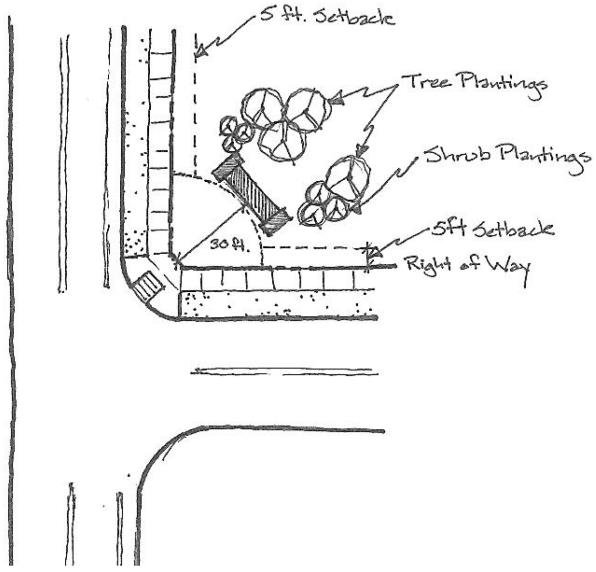
Figure 1a: Dimensioned Site Plan Example
(Ord. 534 (2016) § 7(5) (App. E) (part), 2016)
17.510.040 Prohibited signs.
Unless otherwise exempt or conditionally exempt under this chapter, the following signs shall be prohibited:
A. Off-premises signs unless specifically allowed pursuant to Section 17.510.050, Exempt signs, or 17.510.060, Conditionally exempt signs.
B. Signs or sign structures which resemble or conflict with, or are attached to, a utility pole or traffic control sign, unless otherwise authorized by the director in Section 17.510.060(K), Military Appreciation Signage Program.
C. Signs or sign structures which create a safety hazard by obstructing the line of sight of pedestrians or vehicular traffic, or which obstruct a clear view of official signs or signals as determined by Kitsap County.
D. Signs or sign structures, located in traffic roundabouts, islands, or medians.
E. Signs or sign structures located within thirty feet from intersecting Kitsap County right-of-way lines; see Figure 1a, Dimensioned Site Plan Example.
F. Signs or sign structures which obstruct access to drives, doors, walks, windows, fire escapes or fire escape routes.
G. Signs, temporary or otherwise, affixed to a tree.
H. Signs placed on public property, including Kitsap County right-of-way, except when authorized by the appropriate public agency or specifically authorized in this sign code.
I. Electronic signs outside urban growth areas except traffic control signs and public safety signs as identified in Section 17.510.080, Regulations for electronic signs.
J. Abandoned or unmaintained signs.
K. Stationary or mobile billboards.
L. Signs with animation, flashing, or fluttering lights.
M. Rotating signs.
N. Audible signs, except as mandated or encouraged by the Americans with Disabilities Act.
O. Banner or continuous inflatable or noncontinuous inflatable signs not associated with a special event.
P. Signs placed on a vehicle or trailer to purposefully gain additional signage which would otherwise not be allowed. This does not prohibit the identification of a business or its products on a vehicle or trailer included in the operations of the business.
Q. In the Kingston urban growth area, (1) except for halo lighted signs, internally illuminated signs in the Old Town/Waterfront or Village Green districts as defined in the Kingston subarea plan and (2) mounted or freestanding reader board signs.
R. In a limited area of more intense rural development (LAMIRD), (1) internally illuminated signs, (2) neon signs or (3) electronic signs.
S. Electronic signs in the Old Town district, Silverdale, as defined in the Silverdale subarea design standards.
(Ord. 534 (2016) § 7(5) (App. E) (part), 2016)
17.510.050 Exempt signs.
A sign or modification to an existing sign shall be exempt from review under this sign code and may be constructed without a permit:
A. Historic site markers or plaques, gravestones, and address numbers.
B. Signs required by law, including but not limited to:
1. Official or legal notices issued and posted by any public agency or court; or
2. Traffic directional or warning signs.
C. Seasonal or holiday decorations that do not function as signage.
D. Plaques, tablets or inscriptions indicating the name of a building, date of erection, or other commemorative information, which are an integral part of the building structure or are attached flat to the face of the building, which are nonilluminated, and which do not exceed four square feet in surface area.
E. Religious symbols as recognized by the Department of Veterans Affairs National Cemetery Administration affairs religious symbol list.
F. On-premises directional signs less than four square feet.
G. Garage sale, estate sale, or other temporary signs for similar events less than four square feet.
H. Legal informational signs less than four square feet (e.g., no trespassing or no fireworks).
I. Residence identification signs (e.g., 1234 Road Name: The Smiths).
J. Information signs erected and maintained by the state, county or any city.
K. On-premises window or door signs indicating business hours of operation or when a business is open or closed. These signs may be static electronic signs regardless of where the business is located. The size cannot exceed four square feet.
(Ord. 534 (2016) § 7(5) (App. E) (part), 2016)
17.510.060 Conditionally exempt signs.
A temporary sign shall be conditionally exempt from this sign code and may be constructed, without permits, if consistent with the size, height, duration, maximum number limitations, and other criteria listed below. Unless expressly stated, conditionally exempt signs are not allowed to be lighted, conflict with or impede views of permanent signs or signals, or be located in Kitsap County right-of-way or publicly owned property pursuant to Section 17.510.040, Prohibited signs.
A. A-Frame Sign or Temporary Sign. Only one A-frame sign, advertising wind sign, or temporary sign, not associated with a special event, is allowed per organization and shall only be displayed during business hours, an on-premises sign, and not impede vehicular, bicycle, or pedestrian circulation.
1. An A-frame sign shall have two faces and not exceed three feet in height or width, or exceed a total of six square feet per sign face.
2. Advertising wind signs shall be no more than eight feet tall and not exceed a total of sixteen square feet per sign face.
B. Special Event A-Frame, Banner, Double Post, Inflatable, or Wall Sign:
1. All special event signs shall be placed no more than fourteen days prior to the event occurrence, and removed five days after the event has occurred. Multiple events of the same type (e.g., farmers market every Saturday between March 1st and August 31st). Four A-frame signs are allowed per special event in addition to a banner, double post, inflatable, or wall sign and shall be allowed within the Kitsap County right-of-way, sizing to be consistent with subsection (A) of this section. A-frame signs in the ROW:
a. An A-frame sign shall not impede public vehicular, bicycle, or pedestrian circulation.
b. Attachments, including balloons, shall not be placed on signs.
c. Symbols and directional arrows shall be used as the first order of preference in sign design to minimize wording and enhance safety and legibility.
d. Wire or metal stakes shall not be utilized to secure signs within the county right-of-way. Where anchoring is utilized to stabilize signs within the Kitsap County right-of-way, sandbags shall be used.
2. Banner or wall signs shall be no more than one hundred square feet.
3. Inflatable signs flown more than twenty feet in elevation measured from finished grade shall be required to obtain a sign permit.
4. Special event double-pole signs shall be no greater than thirty-two square feet and must not exceed eight feet in height as measured from the finished grade.
C. Arm Sign. Permanent and temporary arm signs; provided, that the sign conforms to the sign detail sheet (Section 17.510.100(A), Arm Sign).
D. Window Sign. Permanent and temporary window signs; provided, that the sign conforms to the sign detail sheet (Section 17.510.100(I), Window Sign).
E. Flag. Provided the flag is attached to a permanent flagpole or side of a building. A permit may be required to erect a flagpole pursuant to 2009 International Building Code Section 1609.1.1, Determination of Wind Loads, and Section 105, Permits.
F. Political Sign.
1. A political sign is allowed in Kitsap County right-of-way; provided, that a sign:
a. Using metal faces, metal supports, metal frames, or wire frames is prohibited;
b. Is limited to a size no greater than four square feet and may not extend higher than forty inches measured from the point in which it is placed in the ground to the top of the sign; and
c. Shall be removed ten days after an election. After primary elections, political campaign signs endorsing or opposing a successful candidate or ballot measure may remain up to ten days after the succeeding general election.
2. Political campaign sign(s) are allowed on private property and may express a property owner’s endorsement of a political candidate or ballot issue, provided:
a. Political campaign signs are limited to a maximum size of thirty-two square feet; and
b. Political campaign signs on private property must be removed within ten days after an election. After primary elections, political campaign signs endorsing or opposing a successful candidate or ballot measure may remain up to ten days after the succeeding general election.
G. On-Premises Directional Signs. Exit, entrance, or other on-site traffic directional signs are permitted. The maximum height of any directional sign shall be thirty-six inches, and the maximum area shall be nine square feet. No text shall be larger than the directional language text.
H. Community Sign Placed by Kitsap County. A community sign is exempt; provided, that the community and Kitsap County enter a written agreement wherein the community assumes ownership and responsibility for any and all installation, maintenance, repairs, and content of the sign, and conforms to sign policies developed for the particular community sign.
I. Human Sign. A human sign shall not obstruct public bicycle lanes or public sidewalks.
J. Roadside Memorial Sign. Provided, that it meets Kitsap County Public Works Roads and Traffic Roadside Memorial Policy 300.5.
K. Military Appreciation Signage Program. A sign may be placed on Kitsap County owned property provided the sign(s) placement is approved by the director. This includes, but is not exclusive to, banners attached to utility poles.
L. Agricultural and Farm Stand Signage Program.
1. Up to four off-premises A-frame signs shall be allowed within the Kitsap County right-of-way, sizing to be consistent with subsection (A) of this section, with the seller’s name and contact info on back. A-frame signs in the ROW:
a. An A-frame sign shall not impede public vehicular, bicycle, or pedestrian circulation.
b. Attachments, including balloons, shall not be placed on signs.
c. Signs shall maintain a two-hundred-foot setback when approaching an intersection or a yellow and black county warning sign.
d. Symbols and directional arrows shall be used as the first order of preference in sign design to minimize wording and enhance safety and legibility.
e. Wire or metal stakes shall not be utilized to secure signs within the county right-of-way. Where anchoring is utilized to stabilize signs within the Kitsap County right-of-way, sandbags shall be used.
2. A farm stand sign is exempt provided the sign does not exceed six square feet.
3. A farm identification sign may be a permanent arm sign located on the premises, on or adjacent to an easement road leading to the farm, as allowed with written consent from all easement owners. The arm sign shall conform to sign detail sheet, arm sign, requirements.
M. Real Estate Signage Program.
1. All real estate signs must have the real estate broker name and phone number on any and all types of real estate signs. The name and phone number are not required to be visible to the public. All real estate signs shall be removed within ten days of the date of closing.
2. For a single-family residential property, one unlighted on-site arm sign is allowed per street frontage in addition to directional signs located on easement(s) leading to the property for sale and one attached special event banner sign located on the subject property.
3. On-site development “for sale” shall be limited to one sign per development entrance. The sign shall not exceed thirty-two square feet in area, and shall not exceed eight feet in height. A sign permit is required and shall be issued for a three-year period. The permit is renewable annually for up to a maximum of five years.
4. On-site “for rent” shall be limited to one sign per development entrance. The sign shall not exceed twelve square feet in area, and shall not exceed eight feet in height.
5. Open House Events. A maximum of four off-premises arrow signs, A-frame signs, or combination thereof may be used to promote open house events, per property for sale or subdivision. Such signs shall be permitted only when the agent or seller is in attendance at the property for sale or rent and may be located on the right-of-way outside of vehicular and bicycle lanes and sidewalks.
6. Off-premises signs advertising subdivisions shall require a three-year sign permit. The permit may be renewed for up to five years. The sign shall be no more than twelve square feet. A letter of consent from the property owner shall be required as part of sign permit approval.
(Ord. 534 (2016) § 7(5) (App. E) (part), 2016)
17.510.070 Regulations for permanent signs.
A. Sign Types. For the purposes of this sign code there are two types of permanent signs: freestanding and attached. See sign type detail specification sheets, Section 17.510.100, for individual sign type requirements.
B. Quantity. An organization may place one on-site freestanding sign per street frontage in addition to attached signage. One additional freestanding sign is permitted for each additional two hundred feet of street frontage over one hundred feet of street frontage. There is no limit to the number of attached building signs, provided the maximum aggregated sign area coverage is not exceeded.
C. Master Sign Plan. A master sign plan shall be required or allowed pursuant to Section 17.510.090.
D. Attached Signage Total Area. Attached signs (1) may have an aggregated area that shall not exceed two square feet for each one lineal foot of building facade width except when Section 17.510.100(H), Wall Sign, indicates otherwise, and (2) shall not exceed one hundred square feet in area, except it may exceed the maximum if the total sign area is less than ten percent of the total storefront area and except when Section 17.510.100(H), Wall Sign, indicates otherwise. Attached signs shall have a maximum aggregated area of one hundred square feet for all building signs attached to a single building (see Figure 1b, Attached Sign Total Area Example).
E. Sign Illumination. The artificial illumination of signs shall be designed to minimize negative impacts on surrounding properties.
1. Provided an organization is not open for business, signs located within residential areas in urban growth areas and signs located outside urban growth areas (UGA) or Type III limited areas of more intense rural development (LAMIRDs) including schools, churches, government, and quasi-government shall not be illuminated after 10:00 p.m. Signs shall include downcast lighting and not be illuminated before 6:00 a.m.
2. External light sources shall be shielded and direct illumination towards the sign only.
3. Light sources shall utilize energy-efficient fixtures wherever feasible.
4. Pursuant to Section 17.105.110, lighting is to be directed away from adjoining properties. Not more than one foot-candle of illumination may leave the property boundaries.
F. Relationship to Buildings. Signs shall be designed to incorporate the overall architectural style and at least one of the predominant visual elements of the organization’s building or buildings, including, but not exclusive to, the type of construction materials, color, or geometric forms.
G. Landscaping. Freestanding sign applications shall include landscaping in the dimensioned site plan; see Figure 1a, Dimensioned Site Plan Example. Landscaping shall include ground cover or shrubs which accent the sign while not blocking sign lettering or symbols used for recognition. Identification of plant species is not required in the site plan. Native, water-wise plantings are encouraged.
H. Setbacks. Freestanding signs, excluding arm signs, shall be set back a distance of thirty feet from intersecting Kitsap County right-of-way lines pursuant to Section 17.510.040, Prohibited signs, or a distance of five feet measured from the property line, whichever is greater. The nearest sign edge measurement includes cantilevering sign edges. Signs requiring relocation as a result of public projects may be allowed within setbacks if there is no alternative and approval from the Kitsap County public works traffic engineer is acquired to insure that the location will not impede sight distances or the clear zone of traffic.
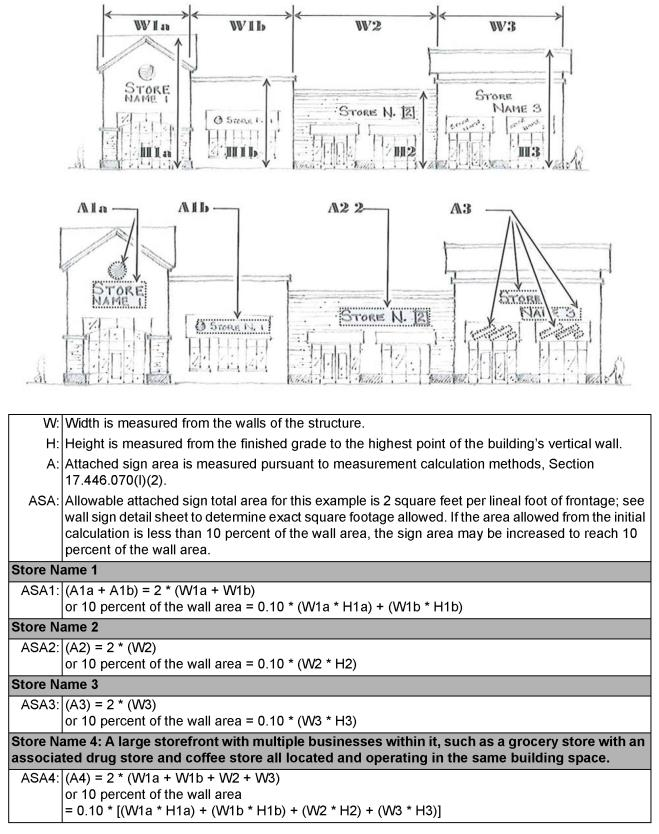
Figure 1b: Attached Sign Total Area Example
I. Measurement Calculations.
1. Freestanding sign height shall be measured as the largest dimension from the highest point of the sign to where the sign intersects with the finished grade; see Figure 1b, Attached Sign Total Area Example.
2. Measurement of the copy area is inclusive to all attributes in and around the sign not immediately related to the structure on which it is attached.
3. Simple geometric shapes (rectangles, triangles, circles, ovals, etc.) shall be used in combination to measure odd or complex text or graphics as seen in Figure 1c, Copy Area Calculation Method.
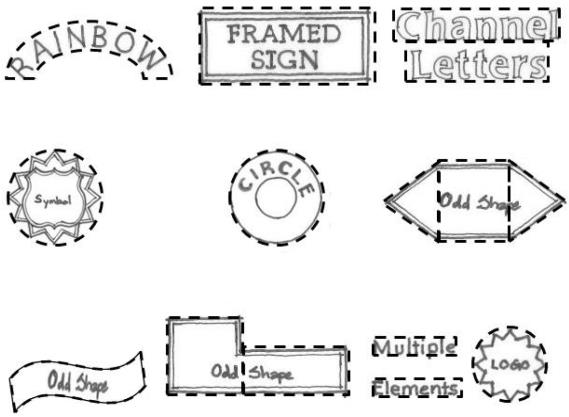
Figure 1c: Copy Area Calculation Method
(Ord. 534 (2016) § 7(5) (App. E) (part), 2016)
17.510.080 Regulations for electronic signs.
Electronic signs are allowed in all commercial or industrial zones within an urban growth area (UGA). Schools, churches, or governments may have an electronic sign in any zone within a UGA. Traffic control signs or public safety signs may have an electronic sign in any zone inside or outside of a UGA. An electronic display shall not exceed fifty percent of the sign size. An electronic sign is not allowed to be part of or in its entirety a conditionally exempt sign. Notwithstanding Section 17.510.070(E), Sign Illumination, the following illumination requirements shall apply:
A. Hold Time. The digital message or static image shall remain on the display for a minimum of eight seconds. No more than three messages shall be displayed within a one-minute time frame.
B. Transition Method. A transition between messages shall be executed with a minimum fade in and out time of one second.
C. Illumination Levels. Electronic signs shall incorporate photocell/light sensors, with automatic dimming technology that appropriately adjusts to ambient light conditions. Displays shall have a brightness level of no greater than three-tenths foot candle above ambient light conditions or shall maintain accordance with Section 17.510.070(E)(4), whichever is more restrictive. An affidavit showing compliance consent shall be required with the sign application.
D. Maintenance. Any permitted electronic changeable message sign that malfunctions, fails, or ceases to operate in its usual or normal programmed manner shall be repaired or disconnected within five days by the owner or operator of the sign. Unless proven to be mechanical failure through no fault of the sign owner, electronic signs found to be in violation of the sign illumination requirements may be subject to code enforcement citations and penalties pursuant to Kitsap County Code.
(Ord. 534 (2016) § 7(5) (App. E) (part), 2016)
17.510.090 Master sign plan.
A. To achieve a more consistent and coordinated signage pattern, a master sign plan shall be required for all new, nonresidential developments of three or more separate tenant spaces that either (1) share the same parcel or structure or (2) use common access and parking facilities. A master sign plan may be allowed for developments of three or more separate tenant spaces that do not share the same parcel or structure.
B. An application for master sign plan must include the following submittals:
1. Signature of all property owners within the master sign plan boundaries.
2. A master sign plan is required to include the size, location and configuration of all proposed and/or previously approved signage.
3. The master sign plan shall identify the number of tenants to be represented in the sign plan.
4. The master sign plan shall include a strategy to provide signage for future tenant changes or increase in number above the original number of tenants identified in subsection (B)(3) of this section. The strategy shall identify how signage will change to maintain conformance with the sign code when the master sign plan is approved.
5. A master sign plan must be approved through a Type II review process (ACUP) consistent with the requirements of Title 21. All signage approved through a previous performance-based development, conditional use permit, variance or other approval that allowed greater sign quantities, square footage or configurations than allowed by this chapter must be amended to conform to the current sign code regulations. Revisions to previously approved master sign plans shall be treated as a Type II review process (ACUP).
C. For parcels under twenty acres in size:
1. An organization may place one on-site freestanding sign per street frontage in addition to attached signage. One additional freestanding sign is permitted for each additional one hundred fifty feet of street frontage over one hundred feet of street frontage. The plan shall meet the following criteria:
a. Signs must conform to the permitted sizes in Section 17.510.100, Sign detail sheets.
b. No one business may comprise more than fifty square feet of each sign face.
D. For individual or contiguous parcels which are twenty acres or greater in size, the following limitations shall apply:
1. An organization may place one on-site freestanding sign per street frontage in addition to attached signage. One additional freestanding sign is permitted for each additional one hundred fifty feet of street frontage over one hundred feet of street frontage. Freestanding signs inside the development shall not be counted against the number of freestanding signs allowed. The plan shall meet the following criteria:
a. Each sign may not exceed two hundred square feet per face and may not have more than two faces.
b. No one business may comprise more than fifty square feet of each sign face.
c. A monument sign shall not be limited by the minimum or maximum height requirements of Section 17.510.100, Sign detail sheets, but shall not exceed twenty-five feet in height.
2. Attached signage shall meet the following criteria:
a. Signs must conform to the permitted sizes in Section 17.510.100, Sign detail sheets, except two blade signs internal to the development shall be allowed per organization, not to exceed twenty-five square feet per face.
(Ord. 534 (2016) § 7(5) (App. E) (part), 2016)
17.510.100 Sign detail sheets.
A. Arm Sign.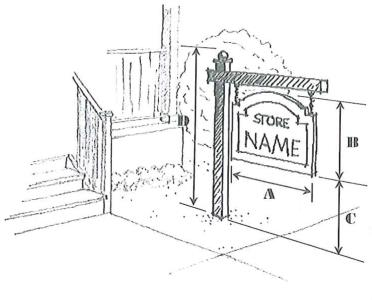
|
Arm Sign: Definition |
||
|
A sign attached to one or two freestanding post(s), with the faces of the sign generally projecting perpendicular to the public right-of-way. |
||
|
Allowed in the Following Zones |
||
|
All zones. |
||
|
Size |
||
|
Width |
36 in. max. |
A |
|
Height |
48 in. max. |
B |
|
Copy Area (B x A) |
6 sf. max. Home businesses within urban growth area boundaries: 4 sf. max. |
|
|
Location |
||
|
Clear Height |
12 in. min. |
C |
|
Overall Height |
6.5 ft. max. |
D |
|
Setback (measured from the closest edge to the property line) |
3 ft. min. |
|
|
Number |
1 per street frontage max. |
|
|
Miscellaneous |
||
|
Arm signs shall be registered with Kitsap County. |
||
B. Awning Sign.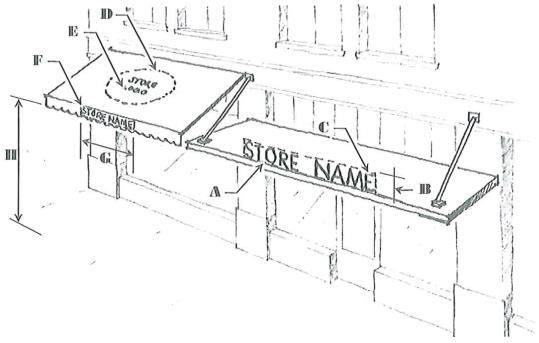
|
Awning Sign: Definition |
||
|
A sign located on a building-mounted shade structure that provides additional functionality as shelter. |
||
|
Allowed in the Following Zones |
||
|
All zones. |
||
|
Size |
||
|
Projecting |
||
|
Sign Area: |
2 sf. per linear ft. of shopfront max. |
A |
|
Letter Height: |
16 in. max. |
B |
|
Letter Thickness: |
6 in. max. |
C |
|
Sloping Plane |
||
|
Copy Area: |
25% coverage max. |
D |
|
Valance |
||
|
Letter Height: |
80% of valance height, 16 in. max. |
F |
|
Letter Width: |
75% of valance width max. |
G |
|
Location |
||
|
Clear Height: |
8 ft. min |
H |
|
Miscellaneous |
||
|
Vinyl or plastic awnings are discouraged in this code. |
||
C. Blade Sign.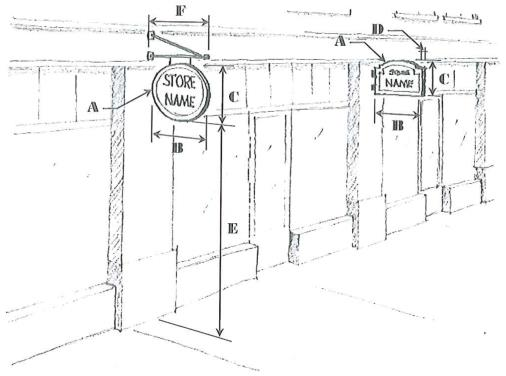
|
Blade Sign: Definition |
||
|
A building-mounted sign projecting 12 inches or more perpendicular to the building, or hung parallel to the building eave, with a maximum area of 10 square feet allowed. |
||
|
Allowable in the Following Zones |
||
|
All zones. |
||
|
Size |
||
|
Copy Area (B x C): |
8 sf. max. |
A |
|
Width: |
36 in. max. |
B |
|
Height: |
36 in. max. |
C |
|
Thickness: |
10 in. max. |
D |
|
Special and creative signs that have a three-dimensional quality may have a greater thickness subject to approval by the director. |
||
|
Location |
||
|
Clear Height: |
8 ft. min. |
E |
|
Projection: |
5 ft. max. |
F |
|
Number: |
1 per storefront max. |
|
|
Miscellaneous |
||
|
The area of a blade sign shall be included in the collaborative storefront coverage ratio. |
||
|
All exposed edges of the sign should be finished. |
||
D. Canopy Sign.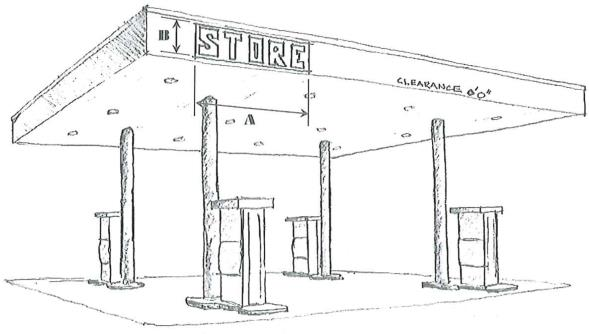
|
Canopy Sign: Definition |
||
|
A sign located on the edge of a freestanding canopy. |
||
|
Allowable in the Following Zones |
||
|
Commercial and industrial zones only. |
||
|
Size |
||
|
Width: |
25% of canopy edge, max. |
A |
|
Height: |
75% of canopy edge, max. |
B |
|
Miscellaneous |
||
|
A clearance height notification will not be calculated into the copy area. |
||
|
The sign shall not extend beyond the edge of the canopy more than 8 inches. |
||
|
Signage shall only be allowed on 3 faces of the canopy. |
||
E. Monument Sign.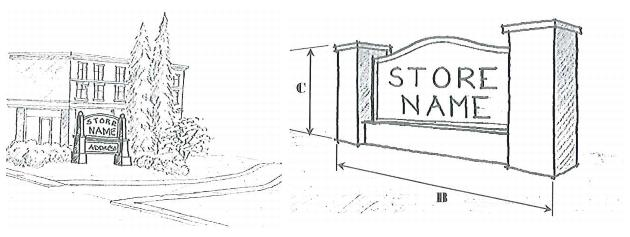
|
Monument Sign: Definition |
|||
|
A freestanding sign, generally having a low monolithic profile such that the sign has the appearance of a solid base. |
|||
|
Application |
|||
|
Typically used in entrances for single or multiple commercial or industrial tenants. |
|||
|
Allowable in the Following Zones |
|||
|
All zones. |
|||
|
Allowed Size by Zone |
|||
|
Zones: |
|
BC, BP, IND, RI, CO, RC, RCO, REC, TTEC, any zone within a Type III LAMIRD |
RR, RP, RW, FRL, NC, UR, GB, UL, UCR, UM, UH, UVC, Kingston CO, SVC, SVR, SVLR, RHTC, RHTR, RHTW, MVC, MVLR, MVR, KVC, KVLR, KVR |
|
Width: |
B |
15 ft. max. |
10 ft. max. |
|
Height: |
C |
12 ft. max. |
8 ft. max. |
|
Sign Area (B x C): |
|
Per face 100 sf. max. |
Per face 50 sf. max. |
F. Pole Sign.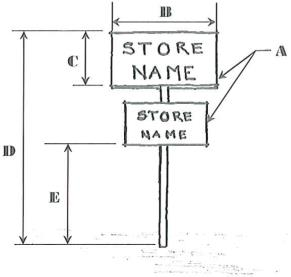
|
Pole Sign: Definition |
|||
|
A freestanding sign supported by one or more structural elements that are either: (a) architecturally dissimilar to the design of the sign; or (b) less than 1/4 the width of the sign face. |
|||
|
Miscellaneous |
|||
|
A pole sign shall only be used if no other feasible freestanding sign alternative exists and only when variances cannot be used. The sign cannot be used to increase visibility beyond a reasonable reach. |
|||
|
Allowed Size by Zone |
|||
|
Zones: |
|
BC, BP, IND, RI, CO, RC, RCO, REC, TTEC, any zone within a Type III LAMIRD |
Kingston CO, SVC, RHTC, RHTW, MVC, KVC, UVC, UCR, UM, UH, NC |
|
Copy Area: |
A |
70% coverage max. |
70% coverage max. |
|
Width: |
B |
10 ft. max. |
8 ft. max. |
|
Height: |
C |
10 ft. max. |
8 ft. max. |
|
Sign Area (B x C): |
|
Per face 100 sf. max. |
Per face 50 sf. max. |
|
Sign Height: |
D |
The lesser of roof height or 20 ft. max. |
The lesser of roof height or 16 ft. max. |
|
Clearance Height: |
E |
8 ft. min. |
8 ft. min. |
G. Roof Sign.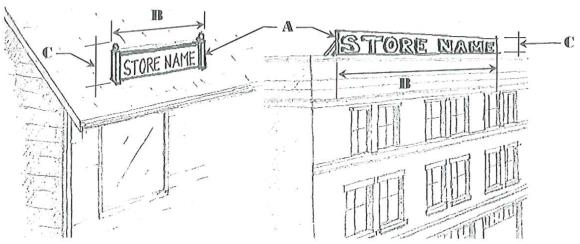
|
Roof Sign: Definition |
||
|
A building-mounted sign erected upon, against, or over the roof of the building. |
||
|
Allowable in the Following Zones |
||
|
All zones. |
||
|
Size |
||
|
Sign Area (B x C): |
3 sf. per linear foot of shopfront, 100 sf. max. |
A |
|
Width: |
50% of storefront width, max. |
B |
|
Height (Flat Roof): |
12 in. min; 3 ft. max. |
C |
|
Height (Pitched Roof): |
50% of the distance between the roofline and top of eave as measured in an elevation drawing, 5 ft. max. |
C |
|
Location |
||
|
Pitched Roof: |
The sign’s center point must be located at or below the midpoint of the roof as seen in an elevation drawing. |
|
|
Miscellaneous |
||
|
A roof sign shall only be used if no other feasible attached sign alternative exists and only when variances cannot be used. The sign cannot be used to increase visibility beyond a reasonable reach. |
||
H. Wall Sign.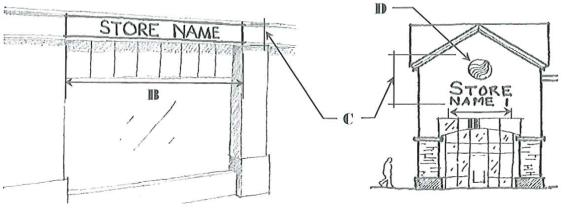
|
Wall Sign: Definition |
|||
|
A building-mounted or wall-mounted sign which is either attached to, displayed, or painted on an exterior wall in a manner parallel with the wall surface, and not projecting more than 12 inches from such surface. A sign located on a freestanding wall or retaining wall not incorporated into a building’s structure shall be considered a freestanding sign. |
|||
|
Miscellaneous |
|||
|
The copy area of a wall sign shall not extend into architectural features such as windows, eaves, cornices, and rooflines. |
|||
|
Allowed Size by Zone |
|||
|
Zones: |
|
BC, BP, IND, RI, CO, RC, RCO, REC, TTEC, any zone within a Type III LAMIRD |
RR, RP, RW, FRL, NC, UR, GB, UL, UCR, UM, UH, UVC, Kingston CO, SVC, SVR, SVLR, RHTC, RHTR, RHTW, MVC, MVLR, MVR, KVC, KVLR, KVR |
|
Sign Area |
A |
3 sf. for each linear foot of storefront or wall facade, 200 sf. max. If the area allowed from the initial calculation is less than 10% of the wall area, the sign area may be increased not to exceed 10% of the wall area. |
2 sf. for each linear foot of storefront or wall facade, 150 sf. max. If the area allowed from the initial calculation is less than 10% of the wall area, the sign area may be increased not to exceed 10% of the wall area. |
|
Width: |
B |
75% storefront or wall width, max. |
75% storefront or wall width, max. |
|
Height: |
C |
8 ft. max. |
5 ft. max. |
|
Graphic or Logo: |
D |
A sign with only a graphic or logo is subject to the maximum sizes defined by A, B, and C of the wall sign type. |
|
|
Projection from Facade: |
|
12 in. max. |
12 in. max. |
I. Window Sign.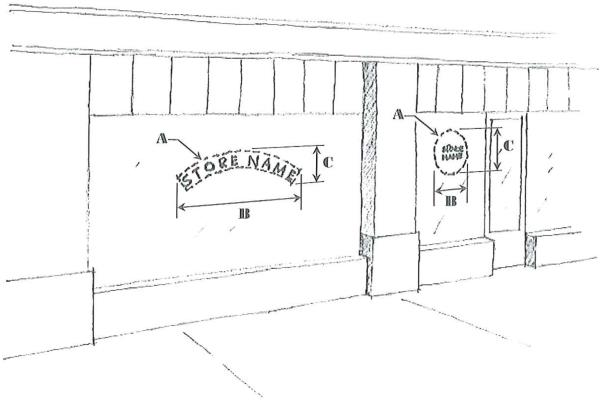
|
Window Sign: Definition |
||
|
A sign that is painted on, attached to, or suspended directly behind a window, the glass portion of a door, or a space providing visual access to the interior of a building (i.e., open garage bays). |
||
|
Allowable in the Following Zones |
||
|
All zones. |
||
|
Size |
||
|
Sign Area (B x C), per Window: |
Permanent signage, 50% max. |
A |
|
Miscellaneous |
||
|
Applied plastic or vinyl cut letters are discouraged. |
||
(Ord. 534 (2016) § 7(5) (App. E) (part), 2016)
17.510.110 Sign maintenance.
All signs must be maintained in a condition as originally permitted. Maintenance shall include landscaping, electrical, material blemishes, structural deficiencies, or other sign conditions changing the visual quality of the sign through neglect. Failure to maintain a sign may result in penalties and permit revocation. Violation procedures and penalty fee schedules shall be according to applicable Kitsap County Code.
(Ord. 534 (2016) § 7(5) (App. E) (part), 2016)
17.510.120 Nonconforming signs.
Notwithstanding Chapter 17.610, Enforcement, the continued existence of lawfully established and permitted nonconforming signs shall be subject to the following:
A. No sign previously erected in violation of any code provision, including without securing proper permit approval, shall be considered a legal nonconforming sign.
B. Legal nonconforming signs are subject to the sign maintenance requirements of this chapter.
C. A legal nonconforming sign must fully conform to current sign code regulations if structural alterations will occur. For purposes of this subsection, normal maintenance, repair, or content change shall not be considered a structural alteration. Installation of an electronic sign into an existing sign shall be considered a structural alteration for the purposes of this chapter.
D. Any legal nonconforming sign which (1) does not promote a commercial product or event and the content of the sign pertains to a time, event or purpose which has elapsed or expired in the preceding three hundred sixty-five days; or (2) is discontinued for a period of three hundred sixty-five consecutive days, without written notice to the Kitsap County department of community development of intent to continue use, shall be deemed abandoned and shall not, thereafter, be reestablished, except in full conformance with this chapter.
E. Any legal nonconforming sign damaged or destroyed to the extent that seventy-five percent of the sign must be repaired may not be restored, and any further signage must conform to this chapter.
F. Government actions, strikes, material shortages, natural disasters, acts of God, and all natural phenomena whose effects could not be prevented by the exercise of reasonable care and foresight, may not be considered in calculating the length of discontinuance, damage, or destruction for purposes of this section. A report from an official investigative organization with the damage or destruction determination, including but not exclusive to insurance and/or police reports, must be provided in order to restore a sign to its most recent noncompliant state of existence.
(Ord. 534 (2016) § 7(5) (App. E) (part), 2016)
17.510.130 Contractor license.
In accordance with Table 1b, Required Contractor License by Sign Type, a permanent sign shall not be erected, altered, relocated, constructed, or maintained by any person who does not hold a valid contractor’s license. All electric signs shall be constructed according to the technical standards of a certified testing laboratory.
|
Sign Type |
Contractor License Required |
|---|---|
|
Arm |
No |
|
Awning |
Yes |
|
Blade |
No |
|
Canopy |
Yes |
|
Monument |
Yes |
|
Pole |
Yes |
|
Roof |
Yes |
|
Wall |
No |
|
Wall Mural |
No |
|
Window |
No |
(Ord. 534 (2016) § 7(5) (App. E) (part), 2016)
17.510.140 Variances.
Notwithstanding Chapter 17.560, Variances, a variance will be granted as a Type II decision. Notwithstanding Section 21.04.210(C)(1)(c), requests for sign variances outside a UGA shall require notification to owners of property within one thousand feet of the subject of the variance. Variances may be granted only when all of the following conditions and facts exist:
A. There are special circumstances applicable to the subject property, including size, shape, topography, location or surroundings, that were not created by the applicant and do not apply generally to other property in the same vicinity or zone.
B. Such variance is necessary for the preservation and enjoyment of a substantial property right or use of the applicant possessed by the owners of other properties in the same vicinity or zone.
C. No other feasible signage alternative exists.
D. The authorization of such variance will not be materially detrimental to the public welfare or injurious to property in the vicinity or zone in which property is located.
E. Variance does not allow for deviations from design requirements herein.
F. The variance is the minimum necessary to grant relief to the applicant.
G. The county may impose conditions on the variance, as necessary, to further the purpose of the sign code and other applicable county codes or ordinances.
(Ord. 534 (2016) § 7(5) (App. E) (part), 2016)
17.510.150 Violations.
Notwithstanding Chapter 17.610, Enforcement, any unapproved signs that are placed in violation of this chapter on public property, including county right-of-way, or that interfere with vehicular or pedestrian traffic will be subject to removal by county staff or their agents, marked and placed in a retrieval yard for the first offense, or disposed of if the first offense mark was applied in a prior incident. Repeat violators may be charged for sign removal.
(Ord. 534 (2016) § 7(5) (App. E) (part), 2016)


